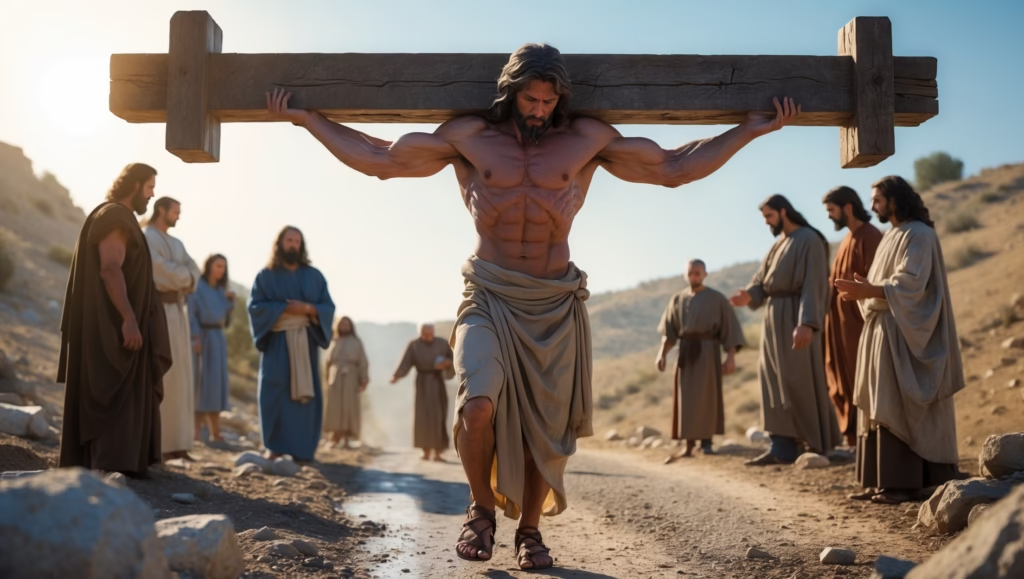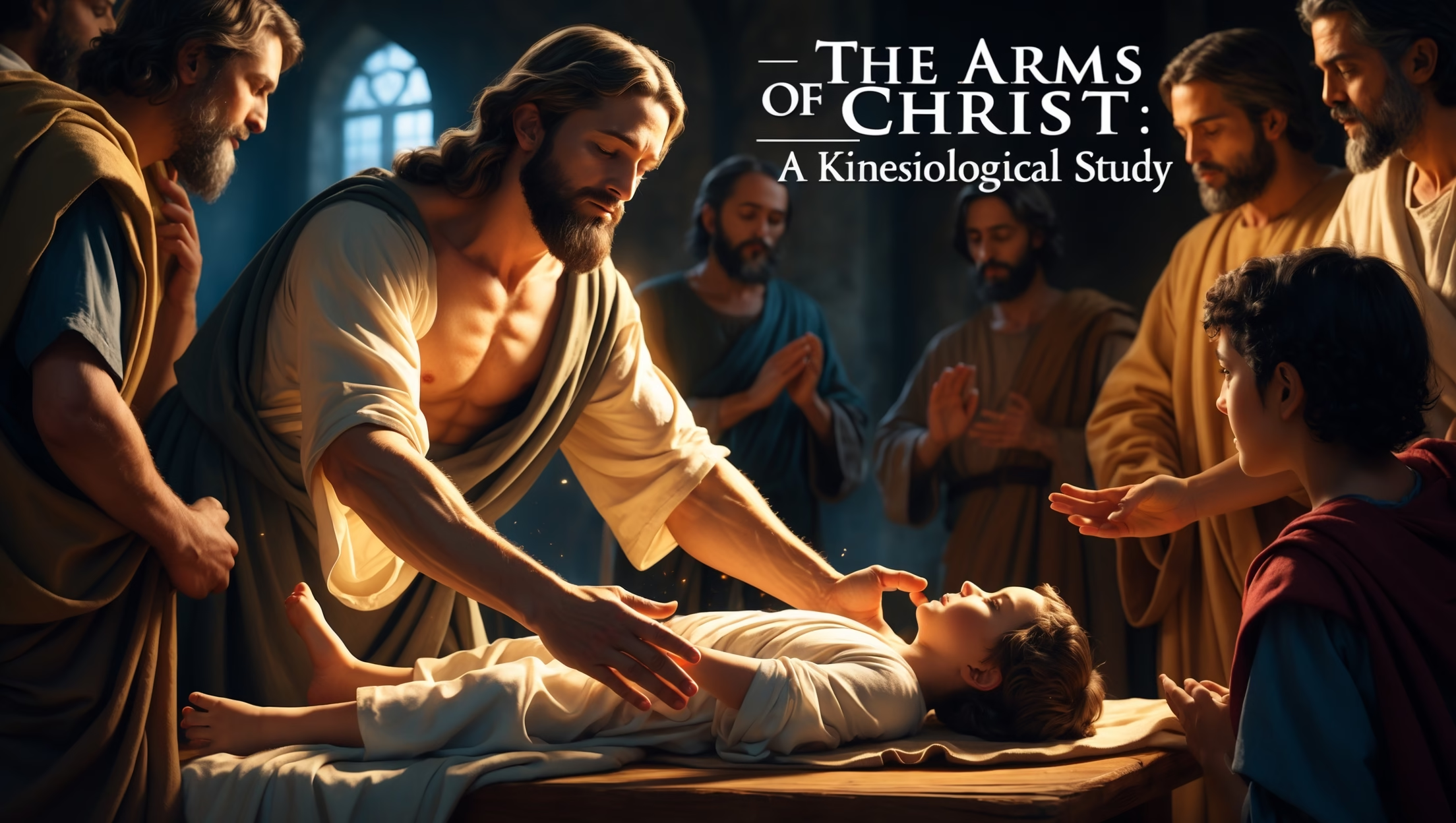Biomechanics of Redemption
The physicality of Jesus’ ministry is often overlooked in theological reflection. Yet, His body—including His arms—played a central role in His acts of healing, teaching, and ultimately, redemption. Kinesiological studies, medical analyses, and archaeological reconstructions offer insights into how the Messiah’s strength, endurance, and anatomy contributed to His mission. By examining the biomechanics of His arms, we gain a fuller appreciation of the human dimension of the divine story.

Carrying Capacity: The Weight of Sacrifice
One of the most striking physical narratives in the Gospels is Jesus carrying burdens. Before the crucifixion, He bore the crossbeam (patibulum) to Golgotha. Medical reconstructions estimate the weight of this beam between 40–60 pounds, depending on wood density and moisture content.
- Musculoskeletal Implications: Shoulder, bicep, and forearm muscles would have been heavily engaged. Historical reconstructions suggest that balancing the weight across the shoulders, combined with walking 600–800 meters over uneven terrain, would have required endurance comparable to modern strongmen.
- Lamb Weight Analogies: Biblical imagery comparing Christ to the Lamb of God (John 1:29) aligns with physical realities. A lamb of 40–60 lbs parallels the load He carried, making the metaphor both symbolic and corporeal.
- Physiological Insight: Sustained load-bearing activates stabilizing muscles in the rotator cuff and upper back, explaining the fatigue, strain, and possible microtraumas documented in forensic studies of crucifixion victims.
Understanding the carrying capacity of Jesus’ arms contextualizes both the literal and symbolic weight of His sacrifice.
Nail Placement: Wrists or Palms?
The exact placement of nails during crucifixion has been debated for centuries. Kinesiological and medical studies, particularly a 2012 Israeli analysis of ancient remains, provide insight:
- Wrist Placement: Modern reconstructions suggest that nails through the wrists could support the body’s weight without tearing through soft tissue, allowing for prolonged suspension.
- Palm Debate: While artistic depictions frequently show nails in the palms, anatomical evidence indicates this would likely fail under full body weight. This debate informs both theological interpretations and artistic representations.
- Biomechanical Consequences: Wrist placement alters muscle tension and joint alignment, impacting how Jesus’ arms extended, bent, and endured stress throughout the crucifixion process.
By studying these details, scholars and artists gain a more accurate understanding of both the suffering and strength embodied in Christ’s arms.
Healing Hands: Strength in Ministry
Before the crucifixion, Jesus’ arms were central to His healing and teaching ministry. Accounts of laying on of hands (Mark 7:32; Luke 4:40) illustrate the intersection of physical touch and spiritual authority.
- Kinesiological Perspective: Repeated gestures of healing—touching, lifting, and guiding individuals—require dexterity, endurance, and precision.
- Therapeutic Implications: The gentle yet firm movements depicted align with modern principles of rehabilitation and somatic therapy, showing that Jesus’ ministry involved both intentionality and bodily awareness.
- Symbolic Significance: The arms served as instruments of divine intervention, connecting physical action to spiritual transformation.
Artistic Evolution: Depicting Strength and Compassion
Throughout history, artists have grappled with representing Jesus’ arms in ways that balance realism and theological messaging.
- Byzantine Art: Depicted elongated, almost ethereal arms emphasizing divine grace over human anatomy.
- Renaissance Masters: Michelangelo and others emphasized musculature, tendons, and realistic proportion, reflecting both human beauty and Christ’s laborious endurance.
- Ethiopian and African Icons: Highlighted strong, powerful arms, reflecting cultural values of resilience and protection, while maintaining spiritual significance.
The evolution of these depictions underscores how the physicality of Christ’s arms communicates theological truths across cultures and eras.
Modern Applications: Faith, Rehabilitation, and Inclusion
The kinesiological study of Jesus’ arms informs contemporary practices and reflections:
- Stations of the Cross in Physical Therapy: Some faith-based rehabilitation programs integrate movement, posture, and stretching inspired by Christ’s journey, emphasizing strength, endurance, and mindful reflection.
- Disabled Christ Imagery: Modern theology increasingly celebrates depictions of Jesus with differently-abled arms or hands, challenging historical norms and emphasizing inclusivity.
- Spiritual Exercise: Practices combining prayer with physical movement—lifting, reaching, or gestural meditation—reflect an embodied spirituality that honors Christ’s kinesiological example.
By engaging with these applications, believers reconnect physical awareness with spiritual practice, demonstrating that Jesus’ arms were not only instruments of suffering but also tools of service and transformation.
Theological Reflections on Strength and Vulnerability
Kinesiological study of Jesus’ arms reveals a profound paradox: strength intertwined with vulnerability.
- Strength: Bearing heavy burdens, extending hands to heal, and demonstrating endurance highlight the Messiah’s physical competence.
- Vulnerability: Nail placements, crucifixion suspension, and fatigue emphasize His humanity, reminding believers that divine mission often involves real bodily struggle.
This duality enriches Christian reflection, showing that power in ministry is not abstract but deeply embodied. The arms of Christ connect believers to both the human experience and divine purpose, inviting meditation on endurance, compassion, and service.
Key Insight: The Arms as Instruments of Redemption
Jesus’ arms, through biomechanics, healing gestures, and crucifixion endurance, serve as a tangible link between the physical and spiritual. By examining their kinesiological aspects, we better understand:
- The literal burden of redemption
- The physical demands of ministry
- The symbolism embedded in gestures of healing and blessing
- The theological narrative of strength through vulnerability
Recognizing the embodied reality of Christ’s arms enriches both devotional practice and academic study, reminding us that faith engages the body as much as the mind or spirit.









